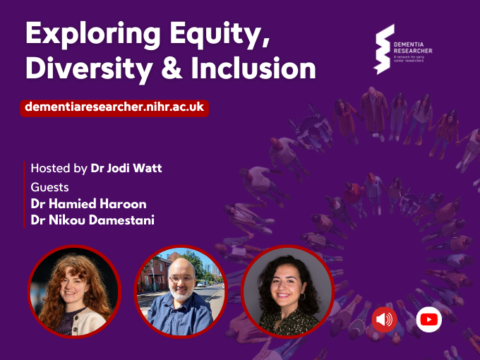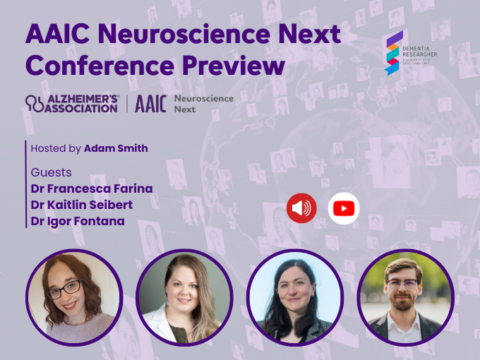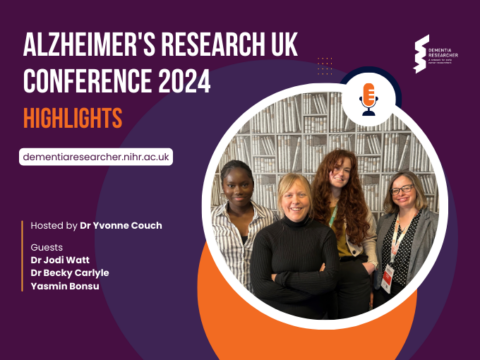The Dementia Researcher, ISTAART Relay Podcast is back for a third, 5-part series. Where the interviewee becomes the interviewer. With five leading researchers discussing their research, their field, and the work of the Alzheimer’s Association ISTAART Professional Interest Area they represent.
Part One – Professor Charlotte Teunissen, interviews Dr Rik Ossenkoppele representing the Atypical Alzheimer’s Disease PIA
Charlotte Teunissen is a Professor in Neurochemistry at Amsterdam UMC. Charlotte explores Biomarkers in body fluids, such as cerebrospinal fluid and blood, to understand the disease and improve care for neurological diseases, especially dementias and Multiple Sclerosis. She is representing the ISTAART Biofluid Based Biomarkers PIA.
Dr Rik Ossenkoppele is an Associate Professor of Translational Neuroscience at Amsterdam UMC and Lund University. His area of research is Alzheimer’s disease and other neurodegenerative disorders, brain imaging, biomarkers, cognition. Rik also happens to be a qualifiied PE Teacher, and he is representing the ISTAART Atypical Alzheimer’s Disease PIA.
The Alzheimer’s Association International Society to Advance Alzheimer’s Research and Treatment (ISTAART) convenes the global Alzheimer’s and dementia science community. Members share knowledge, fuel collaboration and advance research to find more effective ways to detect, treat and prevent Alzheimer’s and other dementias. Professional Interest Areas (PIA) are an assembly of ISTAART members with common subspecialties or interests.
There are currently 29 PIAs covering a wide range of interests and fields, from the PIA to Elevate Early Career Researchers to Biofluid Based Biomarkers and everything in between.
To sign-up to ISTAART (free for students worldwide, and for people of all grades in Low and Middle Income Countries) and a PIA visit www.alz.org/istaart/
To book your place at this years AAIC Confernence visit – https://aaic.alz.org/
Voice Over:
Hello, and thank you for tuning into the third season of the ISTAART PIA Relay podcast brought to you by Dementia Researcher. ISTAART is a professional society and part of the Alzheimer’s Association, representing scientists, physicians, and other dementia professionals active in researching and understanding the causes and treatments of Alzheimer’s disease and other dementias.
Voice Over:
In this five-part series, we have once again asked members of the ISTAART professional interest areas to take turns at interviewing their colleagues and being interviewed themselves, with the interviewee going on to be the interviewer of the next episode. We will be releasing one of these podcasts each day in the build up to the Alzheimer’s Association International Conference to showcase the amazing work of the ISTAART PIAs. So, this week you are going to hear all about fluid biomarkers, atypical Alzheimer’s disease, reserve, resilience and protective factors, immunity and neurodegeneration, and technology and dementia, with some amazing guests.
Professor Charlotte Teunissen:
Hello everyone and thanks for joining us. I am Charlotte Teunissen. I am a professor in neurochemistry and I work at Amsterdam University Medical Centers. I chair the BBB PI, and BBB stands for body fluid biomarkers. Today. I am delighted to be talking with Rik Ossenkoppele. Hi Rik, can I start by asking you to introduce yourself and tell us with which PIA you are involved?
Dr Rik Ossenkoppele:
Hi, SHA many things and great having this, this conversation with you today. Yeah, so my name is Rik Ossenkoppele. I also work at the Amsterdam University Medical Centers, but then at the Alzheimer Center, I also have an affiliation at the University of Lund, and I am currently the vice chair of the atypical Alzheimer’s disease professional interest area.
Professor Charlotte Teunissen:
That is very interesting. Perhaps you can start with a little bit discussion of your research. So, what brought you to dementia research?
Dr Rik Ossenkoppele:
Right, so often from dementia research, you hear about personal situations. Actually, I do not have that. So, there are few dementia cases in my family. I actually, for the first time really encountered during my studies, I studied neuropsychology and I was testing individuals suspected of having Alzheimer’s disease and while doing all these tests, like assessing memory, and language and visual spatial function, and so on, I really realized what a diverse disease it is. So, there was so much for variability in the way people progressed, sometimes very fast, sometimes very slow, the kind of symptoms people had. Some had very strong memory impairments, others were more impaired in their behavior, or in language, et cetera. And that really got me fascinated and especially when I found out that we actually know very little, also about the neurobiology of Alzheimer’s disease and there is actually no cure for it. So, all that together, a very interesting clinical phenotype, lack of sufficient knowledge of disease mechanisms, and lack of a cure made me, and still makes, me super motivated to work on this topic.
Professor Charlotte Teunissen:
So, what is your specialty most? Is it neuropsychological testing, or I thought you were also working on imaging?
Dr Rik Ossenkoppele:
Yeah. That is actually what I’m doing mostly nowadays. What I am trying to do is to understand the disease progression in general, and mainly through neuroimaging, but also more recently through bio fluid markers, as you know, Charlotte and in that work, I … thumbs up and in that work, I’ve done so many things.
Dr Rik Ossenkoppele:
So, one of them is try trying to predict the rate of clinical progression of individuals, but also trying to understand why, why someone manifests with memory impairment and other ones with non-amnestic presentations. And also, why some people with lots of pathology actually progress very slowly over time. Whereas other ones only need a little bit of Alzheimer’s pathology before they show quite severe symptoms. So, I am very interested in why all these differences in the disease progression occur and I started at using imaging and bio fluid markers.
Professor Charlotte Teunissen:
And is your focus on mostly people who are diagnosed with dementia, or also the earlier stages?
Dr Rik Ossenkoppele:
Yeah, so actually, I focus on both stages, but I would say that my focus is a little bit different. So, the heterogeneity of the disease in terms of the clinical manifestation, I mainly study in the symptomatic stage. That’s also when symptoms actually occur and it’s easier actually to also detect differences in the way they present. But I’m also very interested in cognitively unimpaired individuals, for example, having amyloid and tau in their brain and what that means for progression. So, the big question is, can we call this Alzheimer’s disease or are they just at risk? This is a big debate in the field at the moment.
Professor Charlotte Teunissen:
Yeah. So that brings me to the next question, but maybe I know the answer, because I saw a LinkedIn post of you yesterday, but what are the hot topics in your field and especially in the PI-related fields?
Dr Rik Ossenkoppele:
Yeah, yeah, exactly. Yeah, so I would mainly focus on the atypical forms of Alzheimer’s disease. So, first let me quickly define it. So, with atypical Alzheimer’s disease, we mainly refer to clinical phenotypes of Alzheimer’s disease that are non-amnestic, so for example, individuals that have severe behavioral impairments. So, they look a lot clinically, like for example, frontal temporal dementia but in fact, they have Alzheimer’s disease pathology. And similar phenotypes that are driven by Alzheimer’s disease pathology also exist, where for example, the visual spatial problems are key, or people have a lot of troubles in language, for example, speech production, or understanding of language, or this executive function where they have a lot of trouble, for example, planning, or inhibition, for example.
Dr Rik Ossenkoppele:
So, really understanding these atypical phenotypes of Alzheimer’s disease is very important. So, hot topic is still to timely diagnose them because their diagnosis is often missed. If they present at a clinic, many times the initial thought is about something else. And that often causes a delay of many years, which causes uncertainty for the individuals and the surroundings, but also delays sufficient patient management. So, really trying to accelerate the diagnostic process.
Professor Charlotte Teunissen:
Oh, yeah, yeah. Do we have any discoveries lately in these fields, or the fields itself also without you?
Dr Rik Ossenkoppele:
Right. Exactly, yes. Maybe I can actually talk a little bit about some of our own work. So, many of the Alzheimer’s disease phenotypes, so for example, the visual spatial or the language variants, they have diagnostic criteria, and that really improved the diagnostic process. So, clinicians are really better able to diagnose this category, but that was not actually available for the behavioral variant of Alzheimer’s disease until fairly recently. And actually, last year, we published the first research criteria for this variant. So, there are not actually very concrete criteria that researchers and clinicians can use to diagnose this variant.
Dr Rik Ossenkoppele:
I think an accurate diagnosis of these atypical forms of Alzheimer’s disease is especially important with many potential disease-modifying drugs at the horizon where it is crucial, if you’re targeting amyloid or tau, that those pathologies are actually also present in the brain. So, we are targeting the right population.
Professor Charlotte Teunissen:
Exactly, yeah. So, that is very helpful through the fields and how did PIA help your research?
Dr Rik Ossenkoppele:
Yeah, so the PIA really provides a very strong network in general. Maybe I can give two examples of that. So, there is one initiative that is led by Marianne Chapeau and Gill Rabinovitch from the University of California in San Francisco. And what they are doing is that they’re performing a meta-analysis for posterior cortical atrophy, and that is the visual variant of Alzheimer’s disease. And what they are doing is they’re collecting data from many sites across the entire world. For example, they are looking at all sorts of clinical variables, but they also look at amyloid and tau status. They look at genetic information and by pooling those data, because it is a relatively rare variant and only by pooling data, you can establish the contributions of all sorts of neurobiological factors you can say more meaningful things about the clinical presentation.
Dr Rik Ossenkoppele:
And one thing that actually the facilitated is that apart from all the published work, because in the literature, you can see which groups are actually working on posterior cortical atrophy, through the PIA, we are actually able to reach out to many groups that have not published on this phenotype, but actually do see them in their clinics. They are also part of the big meta-analysis now. So, the total sample size has increased massively through the PIA. So, that is one really nice example.
Professor Charlotte Teunissen:
Yeah, that is really nice, yeah.
Dr Rik Ossenkoppele:
Yeah, perhaps I can also mention another one that was initiative started a few years ago. It is actually also about the visual presentation of Alzheimer’s disease. And you can imagine that the traditional neuropsychological tests do not work for this population because visual information is not processed as well as people that don’t have this particular phenotype. So, you need a lot of non-visual cognitive tests, and they vary a lot across centers and perhaps the interpretation differs also a lot across centers.
Dr Rik Ossenkoppele:
So, the idea here was to author a white paper to discuss what are the best cognitive tests for a particular domain and try to harmonize it across centers all around the world. So, when we talk about a particular domain, or impairments in this case, we are talking about the same thing, so the results become more meaningful. The diagnosis becomes better and there is more uniform data collection for this group.
Professor Charlotte Teunissen:
And when you talk about official spatial impairments or official processing, can you give an example? Because I am not familiar with the construct so much but what kind of problems do the patients encounter?
Dr Rik Ossenkoppele:
Exactly, so it is a very wide array of symptoms. So, in general, when people think about Alzheimer’s disease, they think about memory problems, so trouble retrieving very recent events for example, not recognizing phases or names. Well actually, if you are sitting in front of an individual with posterior cortical atrophy or the visual variant of Alzheimer’s disease, you will notice that actually their memory is often quite intact. So, you can have conversations about yesterday’s news, for example, or a football game you’ve both watched, but they suffer from very different problems. And just an example is they can have trouble, for example, simple distinguishing left from right. They have difficulties recognizing particular faces or objects. They have trouble putting their clothes on. They have trouble navigating through space. Sometimes there are difficulties in color perception or motion perception. So, everything related to vision, or actually the processing of vision information, some of these elements get impaired.
Professor Charlotte Teunissen:
Yeah, so it can be anything. Yeah, or it is a wide variety of symptoms then.
Dr Rik Ossenkoppele:
Yeah. There is a wide variety. There is actually, in the diagnostic criteria, there is quite an extensive list. If you meet three of them, you would actually be classified as posterior cortical atrophy, but only when it is an early and prominent symptom. So often, during the course of Alzheimer’s disease, people also develop visual spatial problems, but it needs to be very early on, and it also needs to be the most prominent symptom.
Professor Charlotte Teunissen:
Oh, yeah. Yeah okay, in order for the clinical diagnosis of the visual variant of Alzheimer’s disease? Yeah.
Dr Rik Ossenkoppele:
Yeah.
Professor Charlotte Teunissen:
Yeah, okay. Now a little bit more about the PIA again, can you tell a little bit more about the committee and how your group is organized?
Dr Rik Ossenkoppele:
Yeah, absolutely, yes. So, we are a group consisting of mostly researchers around the world, actually. So, our current chair is Jennifer Whitwell, I am the vice chair, myself. We have Kier Yong, who is the programs chair, Baayla Boon we also know because she worked in Amsterdam as well, is the communications chair. We have a junior trainee called Rosaleena Mohanti and the immediate past chair is Femke Bouwman. She was the chair last year and is still involved, also from Amsterdam, as you know. Yeah, and we are organized in a way that we meet on a regular basis, normally every four to six weeks and we discuss everything that is related to atypicality in Alzheimer’s disease.
Professor Charlotte Teunissen:
Oh yeah. And do we also have working groups?
Dr Rik Ossenkoppele:
Yeah, we have working group. So, the project about the cognitive testing in the visual variant of Alzheimer’s is an example of that. So that was really based on our working group, for example, yeah.
Professor Charlotte Teunissen:
Oh yeah, very interesting. And how can early career researchers who are now listening become involved?
Dr Rik Ossenkoppele:
Yeah. First of all, they are more than welcome. We welcome them with open arms. So, there are a couple of things to consider. So, early career researchers that have, for example, specific ideas or questions, or are looking for collaborations, they can send an email to our communications chair that is Baayla Boon. You can find our email address on our website and maybe we could even include the email address in the in-show notes of this podcast, or people who know my email address can also email me, of course.
Dr Rik Ossenkoppele:
Then we can include it, for example, in our newsletter that we send out, or we can put it on our webpage. We have a Twitter account, so we can share everything related to that. So, that is one way to spread ideas. Not ideas, we are always looking for people that are interested in participating, for example, in journal clubs, or webinars. So, if people have ideas, please contact us. And maybe the most direct way to become a [inaudible 00:15:34], is actually to become a part of the executive committee. The new position will come available very soon. So, we always have one junior trainee in our committee. So, people that are interested, I encouraged to apply for that position.
Professor Charlotte Teunissen:
Okay, that is a nice call. And what activities do you have plans for upcoming year or will the early career researchers have opportunities to meet you as AIC? Are there any sessions, plans, for example?
Dr Rik Ossenkoppele:
Yeah, absolutely. So, two things, so about the aims of our PIA first. So, like the past couple of years, we organized many, many journal clubs and webinars. For example, last year we had one on the behavioral variant of Alzheimer’s disease and we had another one on language presentations of Alzheimer’s disease, where there is still a lot of debate about the specifics. We had three experts debating each other. That was actually really nice. The other one is, what we further to aim to do is so far in our committee, we have mainly people working in either the neuropsychological or biomarker aspects of Alzheimer’s disease, as well as neuropathology. But we would actually welcome more people that work in health or social care, because we think our PIA is very relevant for that as well.
Dr Rik Ossenkoppele:
You can imagine if you care for individual with Alzheimer’s disease, it matters a lot what kind of symptoms they have, what needs they have. So, we would really like to welcome the people that are engaged in that particular field. And finally, and this is not definite yet, but we have reached out actually to an editor because we plan to write a textbook based on atypical Alzheimer’s disease, where we describe in detail the clinical presentation, everything we know about the neurobiology, about the care system in place, future directions. So, that is probably not going to be achieved within the next year, but that is on our agenda for the near future.
Professor Charlotte Teunissen:
Yeah, so you really plan to define atypical AD. Do you think in the long term, just on the contents still, will it stay like a subtype of AD, or do you think that it may even become a separate disease entity?
Dr Rik Ossenkoppele:
Yeah, this is actually a great question. So, we quickly touched upon the hot topics in the field, and we only had opportunity to discuss one, but this is definitely another one. I think you can approach this from two sides. So one is, should we actually treat them separately or should we consider it as an entire continuum? So, if Alzheimer’s disease and it goes in different directions and what we now call atypical are just extremes of a continuum. That is a possibility and which I think is the most likely possibility. Reason is they share the similar biology. So, they have amyloid plaques, they have tau tangles. The only thing is they have them, especially the tau tangles, in different parts of the brain and parts of the brain and the networks the tangles deposit, which has a major influence in the clinical manifestation. So, I think it is the same disease, but there’s just a different manifestation.
Professor Charlotte Teunissen:
Yeah, and because it is the same biology, probably they need the same treatments, if you want to target the biology. But yeah, if it tangles are in different location, it is a different biology you could argue.
Dr Rik Ossenkoppele:
Yeah, right. But I guess if you are thinking about anti-tau or anti-amyloid treatments, I think that could apply to any phenotype of Alzheimer’s disease. But I think it is quite likely that the mechanisms that make those proteins misfold, for example, that they could actually differ between subtypes and maybe, there’s a different degree of the neuroinflammatory response or there are specific cell types involved. So, there are many mechanisms that can potentially differ. So, I agree with you that there are neurobiological differences. Then in common, the presence of amyloid and tau pathology, but other neurobiological aspects are likely to be different.
Professor Charlotte Teunissen:
Yeah. So, it sounds like a very exciting field because there is still a lot to be discovered. And nowadays we have the tools also for discovery, so it is a nice area to work in, I think. Okay, thank you. It is time to end today’s podcast recording, but before we go, I do have a final question. So, what advice would you give to any aspiring dementia researchers out there who think of looking into dementia?
Dr Rik Ossenkoppele:
Yeah, it is a really nice question. So first of all, I think anyone that is considering it is entering a very dynamic field at the moment. So, you are one of the leaders in the biomarker field where a lot has happened last year, for example, the advent of blood-based biomarkers. We have for the first time, a disease-modifying treatment being approved by the FDA, although somewhat controversial, whether it has a cognitive benefit, but there are many promising events happening and et the horizon.
Dr Rik Ossenkoppele:
So, I think it is actually a very good time to enter the field because many things are changing. We are making good progress in understanding the disease. Good news is that there are still a lot of work to do, as you said. So, we definitely need to understand the disease better. My advice to early career researchers is really to follow your curiosity. That has always driven me. If you are working on a problem that generally interests you, you will, you will work on it automatically. The motivation is intrinsic. You will be fascinated by studying it and learning more about it. So, follow your interest and the rest will follow suit.
Professor Charlotte Teunissen:
Yeah, so that’s fantastic advice. So, thank you to Rik for taking time to join us today and also for the listeners.
Voice Over:
Thank you for listening. You will find profiles on today’s panelists and information on how to become involved in ISTAAR on our website and dementiaresearcher.nihr.ac.uk, and also at als.org/istaart. We will be back tomorrow with the next recording in our ISTAAR PIA relay podcast series. Finally, please remember to like subscribe and leave a review of this podcast through your website, iTunes, Spotify, SoundCloud, and in all the other places you find your podcasts. Thank you.
END
Like what you hear? Please review, like, and share our podcast – and don’t forget to subscribe to ensure you never miss an episode.
If you would like to share your own experiences or discuss your research in a blog or on a podcast, drop us a line to adam.smith@nihr.ac.uk or find us on twitter @dem_researcher
You can find our podcast on iTunes, SoundCloud and Spotify (and most podcast apps) – our narrated blogs are now also available as a podcast.
This podcast is brought to you in association with Alzheimer’s Association, Alzheimer’s Research UK and Alzheimer’s Society, who we thank for their ongoing support.

 Print This Post
Print This Post




